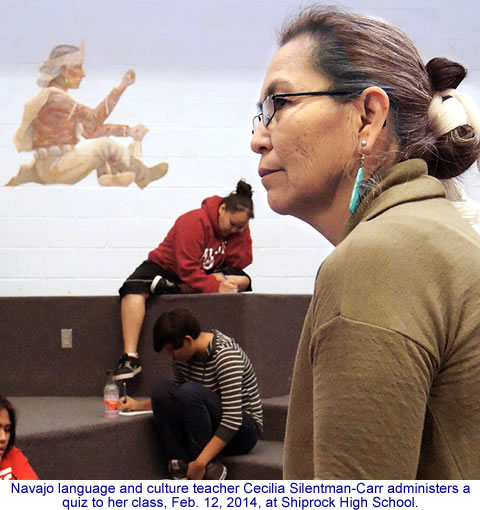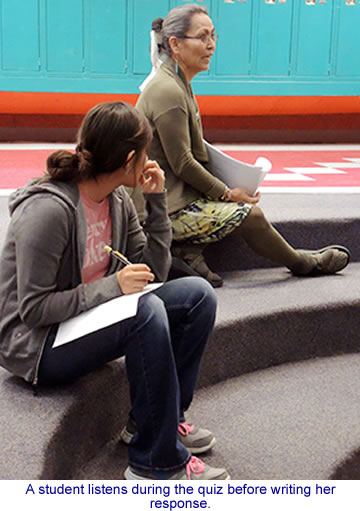 |
Canku Ota
|
 |
|
(Many Paths)
|
||
|
An Online Newsletter
Celebrating Native America
|
||
|
March 2014 - Volume
12 Number 3
|
||
|
|
||
|
School District Emphasizes
Navajo Language and Culture Classes
|
||
|
by Ashley McElroy, CCSD
Public Relations
|
||
|
They listen intently to what she's says during a quiz to give the right response in Navajo. If you're not familiar with the Navajo language it may be hard to understand what Silentman-Carr and her students are saying during class, but she says the more they hear and speak, the more fluent they become. "When students come in, to the time they leave, I talk to them in Navajo. It's a continual thing every day," she said. Navajo language classes are one way the Central Consolidated School District promotes diversity and multicultural education in the schools. CCSD's Bernice L. Pioche Benally Cultural Heritage Center is working with all 16 CCSD schools to ensure students have the opportunity to learn and pursue their Navajo language and culture. Every elementary, middle, and high school in the district has Navajo language and culture classes available. Dr. Wynora Bekis, the district's Multicultural and Bilingual director, says they are working to develop and continue programs to immerse students as much as possible in the Navajo language. "They may hear language in the home but the instillation of pride is what we want to support," she said.
"When a child is asked to use the language to describe concepts or tell a story, we're building the vocabulary," Bekis said. Silentman-Carr, who has been teaching Navajo language at Shiprock High School for the past 4 years, started her teaching career in 1997 at Newcomb Middle School. She says she has a passion for teaching, and she gets an uplifting feeling watching her students develop their language skills. She says the Navajo language is an important aspect of the Navajo culture. "We try to instill in students why they need to learn their language and pass it on to the next generation," she said. Silentman-Carr says she has students of all fluency levels come through her door, and writing and speaking are the focus of all levels of the classes. In level one, there's an emphasis on learning the alphabet and phonetics. At the beginning of the year she gives her students a phrase list of everyday sayings. Students focus on those phrases and practice them in class and at home. Silentman-Carr says parents are also learning from the students and that it's particularly exciting when the parents tell her what they've learned along with their children. "When the parents come in that's when I know the students are learning," she said.
"I think they really prefer to do something more hands on. They want to be entertained in a sense." Her advanced Navajo three class did just that. The students created a booklet written in Navajo about topics they've been learning in her class. Silentman-Carr's class also works on projects and activities during seasonal times. Practices like string games are traditionally done in the winter, so she had her students practice string games as well as write poems related to the string games. For the rest of the year Silentman-Carr's class will also start preparing for the Knowledge Bowl, where they will present projects entirely in Navajo. The Bernice L. Pioche Benally Cultural Heritage Center also put together the Navajo Literacy Program's Family Learning Night for students and parents to learn Navajo together. Bekis said it's a good bonding experience for the families. "You're taking away the TV and you're taking away the chores. It's just quality time with the child in the classroom," she said. At each Family Learning Night session the teacher tells a story relating to the night's theme. The three themes for the sessions are creation stories, coyote stories and shoegame stories, with the last night concluding with an actual shoegame. "It's during that time we capture that essence and encourage the stories to happen," Bekis added. The cultural center is also hosting the Elementary Bilingual Showcase Feb. 21, 2014 at the Phil Thomas Performing Arts Center in Shiprock. Students from Eva B. Stokely, Ojo Amarillo, Ruth N. Bond and Newcomb elementary will present what they've learned in the Navajo language. Each class will have twenty minutes to perform. Bekis says it's a time for the students to really get creative with what they've learned. "They can tell stories, share stories, do puppetry, dramatize a play so that's their morning to shine," Bekis said. And as the school year continues, Bekis says the cultural center is continually working on programs to help students embrace their language and culture. "We're giving the children what's rightfully theirs, were just fostering that and we want to be that positive influence on their lives," Bekis added. |
|
|
||
|
|
||
| Canku Ota is a free Newsletter celebrating Native America, its traditions and accomplishments . We do not provide subscriber or visitor names to anyone. Some articles presented in Canku Ota may contain copyright material. We have received appropriate permissions for republishing any articles. Material appearing here is distributed without profit or monetary gain to those who have expressed an interest. This is in accordance with Title 17 U.S.C. Section 107. | ||
|
Canku Ota is a copyright ©
2000 - 2014 of Vicki Williams Barry and Paul Barry.
|
||
 |
 |
|
|
The "Canku
Ota - A Newsletter Celebrating Native America" web site and
its design is the
|
||
|
Copyright ©
1999 - 2014 of Paul C. Barry.
|
||
|
All Rights Reserved.
|
||
 Shiprock
High students gather around their Navajo language teacher, Cecilia
Silentman-Carr.
Shiprock
High students gather around their Navajo language teacher, Cecilia
Silentman-Carr. CCSD
opened its first Navajo language immersion magnet school in the
fall of 2013 at Eva B. Stokely Elementary in Shiprock. The magnet
school classes are optional for students. Beckis said the classes
are a way to help students understand the Navajo way of life and
why their language is so important.
CCSD
opened its first Navajo language immersion magnet school in the
fall of 2013 at Eva B. Stokely Elementary in Shiprock. The magnet
school classes are optional for students. Beckis said the classes
are a way to help students understand the Navajo way of life and
why their language is so important. But
for her more fluent students, Silentman-Carr assigns projects that
take more time and language skills.
But
for her more fluent students, Silentman-Carr assigns projects that
take more time and language skills.